Anatoly Beliakov
The Underground Floor of Moscow
The Moscow Metro is not just another rapid transit system. It is the most grandiose architectural monument of the Soviet era. Grand, majestic, sublime it was built to be a visual proof of the socialist state's might. It was not just for getting from point A to point  but for adoration like the Lenin's Mausoleum or the Exhibition of People's Economy Achievements. Its social function was close to that of the famous Passages couverts de Paris of the late 19th century - it was making splendor the property of the masses. The splendor was unprecedented as it took more noble stones to decorate the first line stations than to build all of the Russian Emperors' palaces.
And the splendor was easily accessable - for five copecks fare (the price of five match boxes) anyone could enjoy marble benches, touch cool granite columns or look up at massive brass chandeliers. Expanding to the needs of the megacity the Moscow Metro preserved its status of a recognized wonder of the world. Western art critics and tour operators include it among the Ten Places That You Want To See Before You Die naming Mayakovskaya, Kievskaya and Komsomolskaya the most interesting stations.
STATION-PARKS
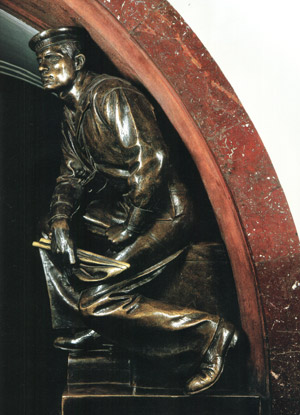 |
The Moscow Metro is by no means the oldest in the world. That title belongs to the London Underground that began operations in 1863. Another famous rapid transit system - the New York City Subway - opened its first section in 1904. Meanwhile the history of the Moscow Metro is just 70 years old. The first line with 13 stations opened on May 15, 1935, between Sokolniki and Park Kultury with a branch to Arbatskaya and Smolenskaya which reached Kievskaya in April 1937. In March 1938 the Arbatskaya line was prolonged to Ploschad Revolutsii (Revolution Square) and Kurskaya. In September 1938 another line opened between Sokol and Teatralnaya running through the famous Mayakovskaya. The whole country was waiting to see the first Metro line to open, and opening of each new line became a holiday for Moscovites and guests of the Soviet capital. They would spend hours in the Metro getting out of the trains at each station to admire the Mayakovskaya mosaics by Alexander Deineka or the statues of soldiers, sailors, workers and farmers by Matvey Manizer at the Revolution Square station. First Metro riders had to go deep down to the trains by feet as only four of the first line stations had escalators - Okhotny Ryad, Dzerzhinskaya (now Lubyanka), Kirovskaya (now Chistiye Prudy - Clean Ponds) and Krasniye Vorota (Red Gates). The rest had just staircases. But the hard way up after a ride did not spoil the impression from the stations that were planned as sort of underground "parks of cultural rest" open all year long - without breaks for severe Russian winters. Following government instructions architects built Metro stations so that they did not resemble railroad ones. That's why first designs are practically devoid of the road theme - their dominating ideas are relaxation, comfort, solemn stability. |
The Metro stations looked like underground palaces or even ancient temples with their colonnades, arcades, floor lamps in the form of sacrificial cups, special effects of artificial lighting. Foreigners were astonished to see that naves and pillars in the Metro were faced with onyx, which in their countries was used to make desk-sets considered to be a sign of wealth and luxury. But to use onyx for columns! "It seems to me that people who attach such importance to luxury and light in building Metro has already built the most important things and is sure of its future", - wrote the famous French writer and pilot Antoine de Saint-Exupery who visited Moscow in 1935 as a special correspondent of the Paris-Soir newspaper.
The Metro ideological message was getting across -foreigners could see with their own eyes advantages of the socialist system.
Just think of it: to construct the first 12 kilometers of the Metro its builders had to take out 2.3 million cubic meters of unearthed ground and to pour 842.5 thousand cubic meters of concrete, and it was done in one year while it took 10 years to carry out a comparable volume of work in Berlin!
METROPOLIS
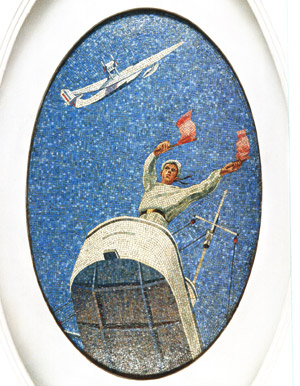 |
As a matter of fact Moscow as it was envisioned by comrade Stalin, "the leader of all times and peoples", is a ghost city. If you know the location and design of some Metro stations you could easily imagine the mind-boggling megapolis that Stalin wanted to see but that was not destined to be built. The new "underground floor" of the old city was to become a foundation for a new majestic Moscow of the future. Many Metro stations were designed as elements of buildings to be erected and their structural load was taken into account. Thus Mayakovskaya station became a "basement" of Tchaikovsky Concert Hall and its architect Dmitry Chechulin had to insulate the hall against the noise of the station engine-room and passing trains. Ploschad Revolutsii entrance was to become a part of a gigantic movie theater complex to be built opposite the Bolshoy Theater. And until 1957 Kropotkinskaya, one of the first Metro stations opened on May 15,1935, was called Palace of Soviets -same as an enormous superstructure planned to be erected nearby with a 100 meter high statue of Lenin on top of it. The total height of the building was planned at 415 meters, taller than the Empire State Building, the tallest skyscraper of that time... The mammoth buildings have never been constructed: after Stalin's death a campaign against "architectural extravagances" started in 1955 and Stalinist Empire Style gave place to pragmatic standarized architecture. Stalin's name sank into oblivion together with that style, dozens of his statues were demolished, splendid bas-reliefs and mosaics with his images were destroyed. Although they say that some portraits are just covered with thick layers of plaster easy to remove... |
UNNOTICED BEAUTY
People get accustomed to good things quickly. And today very few Moscovites would slow down at a busy station to take a look at beautiful mosaics and high reliefs of some of the best artists of the Soviet past. What for? It's all here and won't go away. We can look at it some other day, some other time.
To attract attention beauty sometimes has to be seen in a new light, by a different angle.
"To show the Metro in a different light, to impress its beauty - that was the task we set ourselves while working on the book "Moscow Metropoliten", - says Irina Ostarkova who heads the Interros company publishing program. - Thanks to photoartists, new color correction technologies and highest quality polygraphy we succeeded in creating a unique exposition-book whose "exhibits" a reader can almost touch".
The book "Moscow Metropoliten" was created in the Interros by an outstanding team of writers, reporters, designers, photoartists, each one of them a unique personality, first among equals in their own field. And the book turned out to be on the level with the first Metro line stations created by the world reknowned architects and artists. Even color correction - an operation that today is usually done by a computer - was in case of the "Moscow Metropoliten" done by hand by professional artists.
"Unlike a soulless computer an artist is capable of illogical and therefore nonstandard extraordinary decisions, - says the project art-director Arseny Meshcheryakov. - In our project such decisions were often absolutely necessary. Our photoartists took photos of Metro stations as they are today. Many mosaics darkened by time had to be "restored" by means of color correction, and many pictures in our book look brighter, richer, more vivid than the originals. Some pictures had to be brought closer to the viewer because in real life the height of the ceilings makes it impossible to see details. Taking in advance a close look at all the Metro stations we together with the photoartists made a decision to make short and not long shots as no one yet did close-ups of the Moscow Metro. And that became the concept of our book".
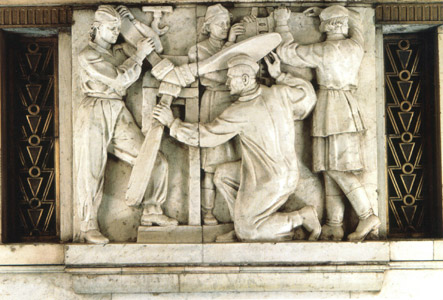 |
The "Moscow Metropoliten" is rich not only in its outstanding collection of pictures but in its unique text material - personal impressions of contemporaries, recollections of project authors, archive extracts, complete metro glossary that gives a reader the opportunity to enrich his or her vocabulary with such words as "alfresco", "archivolt" or "cartouche"... Each new book of the Interros is a special event for the Russian book market, a valuable contribution to the Russian publishing art. Such is an opinion of publishing industry professionals confirmed by prizes and rewards given to Interros books. For example, the two volume "Russian Theater. Illustrated Chronicles of Russian Theatrical Life" was awarded a first class diploma in the nomination "Books on Art", and "Moscow Metropoliten" won a special diploma for the best photography at the "Art of Books. Traditions and Search 2004" competition. |
Photoartists Sergei Birichev and Roman Suslov recall their work in the Metro with special feelings not because of its technical difficulties but for the unique atmosphere of one of the most mysterious places of Moscow.
HIGH SECURITY ZONE
The Metro is a "regime object", a high security zone with its special rules and regulations. For example it is forbidden to take photos in the Metro. But the camera men were working there for four months quite officially - after getting a special permit from the head of the Moscow Metro system Dmitry Gayev.
There were certain conditions: Birichev and Suslov were to be accompanied by a militiaman and an electrician who were provided by the Metro administration and were to help them. The camera men were not allowed into the tunnels and had to present all photos made at the Metro stations for approval. They were working at night - from 1 am till 4 am: the Moscow Metro serves about 9 million people a day and the photographers gave up the idea of working during the daytime. Three night hours set for making photos passed by quickly, so once they did not notice that it was already time for the Metro passengers to come. The station opened its doors and was immediately full of people. At 5:30 am a crowd nearly swallowed the team with all their equipment... But even after the working hours the Metro is working. When passengers leave, the stations are immediately filled with people in yellow work robes. It looks as if the underground people are coming back home. They start cleaning and repairing and building with knocking, gritting and rumbling noises. The Metro is in constant need of repairs. Something is leaking, some cables are on the verge of short circuit or a tile has come down from the wall. There is always something to do. | 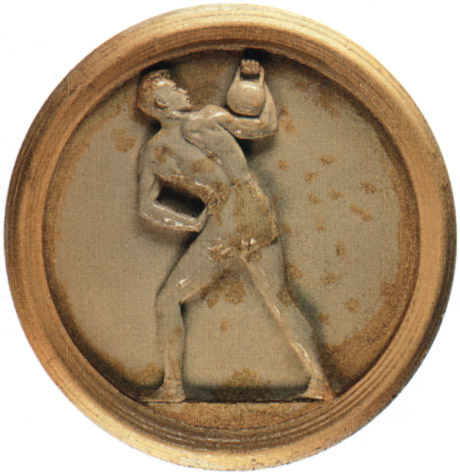 |
And each station is a world of its own. Each has got its own temper, its own air, even people there are different - at some stations they are all tall and stalwart, at others they are short, at some they are cheerful and open hearted, at others they are nervous and bad tempered. It must be that stations themselves influence people. Some of them depress you while others put you in good and high moods. As if it was specially planned for people to go through different moods passing from one station to another. Besides each station has its own relations with the outside world. Some stations are in discord with it, others are in harmony. Such is, for example, Ploschad Revolutsii. Despite all its pomposity and "totalitarianism" this station gives you a cozy feeling. When the camera men were working there a second exit was made ready to open, and a team of welders was making a lot of noise accompanied by shafts of sparks. But all that was no nuisance to the photoartists who passed from one statue to another in an almost poetic mood. But it was not easy to find a good model among the sculptures as many of them are in a state of decay and not because of their age but due to the fact that the Metro passengers like to touch and stroke them. Bronze sailors there have more than their fair share of bad luck: "art connoisseurs" keep on stealing their handguns.
The Metro administration has to keep several spare guns so that it can rearm the robbed sailors. But at the time the camera men took photos there they could not find a single sailor with a gun. Many other statues are in no better shape. Frontier guard shepherd dogs' noses are nearly gone as students believe that stroking those noses helps to pass exams successfully. They think it helps even more than having a five-copeck coin in one's shoe or being cursed by friends at the time of exams.
LEGENDS AND MYTHS OF THE UNDERWORLD
The Metro is one of most mysterious places of Moscow with lots of legends. Each station has its own mythology. The staff of Belorusskaya station may show a mosaic calf that turns its head wherever you go. It gives a tremendous impression.
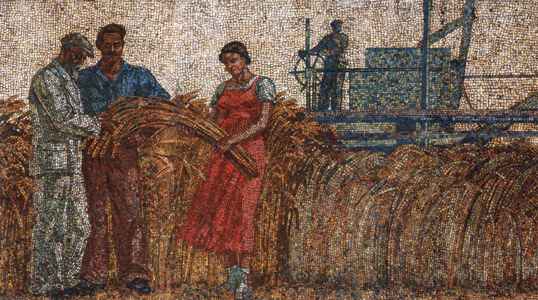 |
And those who work at Mayakovskaya station would say that there are two Mayakovskayas, the second one exactly like the first with the same naves and Deineka's mosaics but all covered with cobwebs and closed to visitors. You can often hear stories about "Metro Two", a parallel secret subway system linking the Kremlin with key buildings and strategic underground command posts. Purported maps of the second Metro can easily be found on the Internet. They say that dog size mutant rats live in the tunnels, that there are underground mushroom plantations and cloning laboratories. It's hard to say whether any of that is true but the photographers have seen none of these. |
As far as modern mythology is concerned there are stories about the Metro extreme "sports". For example, there is allegedly a game of Who Can Stay Longer in the Metro Without Going Out. To play the game you should know very well where in the Metro it is possible to eat, to go to a rest room, to wash oneself, to sleep. But it's hard to believe in the feasibility of such a game as the Metro militia is very watchful and efficient.
MUSEUM UNDER MOSAIC SKIES
When you take the Metro you don't have enough time to look around and see things. Many of them go unnoticed as you always rush somewhere, as you are always in a hurry. But if you stop and do look around you have a feeling of visiting a museum.
Close any of the central stations for transportation, start selling museum guides at the entrance and everything is ready for a tour. It's a pity that there's so much beauty that so few ever take notice of. Is it of any interest to anyone at all? Who is ever looking up to see Deineka's mosaics at Mayakovskaya? Who would slow down to enjoy Lancere's panels at Komsomolskaya? Watching crowds you will find that there are such people but there are very few of them, maybe one or two in a thousand. And those who are always pressed for time can take the "Moscow Metropoliten" book and turn over its pages at the quiet of their home admiring the ever lasting beauty of the Moscow Metro.